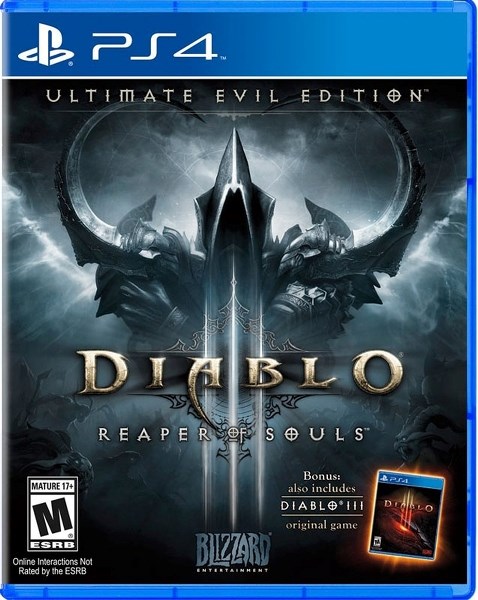It is one of my fondest video game memories. The year is 1997 and I have discovered Diablo, a dungeon-crawler unlike anything I had experienced before. With its gripping story, detailed characterization, and randomized levels, the hours melted away in scores. It was therefore in hopes of recapturing that feeling of immersion that I sat down to play Diablo III: Ultimate Evil Edition. And immersed I was. With an incredible story steeped in myth and religious icons, jaw-dropping cut scenes that draw you into the battle of good over evil, and unprecedented replayability through riveting multiplayer, Diablo III not only lives up to the name and the hype, but establishes itself – yes I’ll say it – as the greatest dungeon-crawler ever released on a console.
Naysayers may look on the words “Ultimate Evil Edition” with skeptical eyes, questioning the need for a new edition, pondering whether this is indeed the “ultimate” version of a Diablo game or whether this is simply another pawn in the long line of recently “remastered” games being re-released for this new generation of consoles. I initially felt the same pessimism, seeing more of a cash-grab than a truly improved experience. I was wrong. I also thought that having to replay the game in order to try out the new character (Crusader) would be tedious. Hardly. Having played both 2013’s Diablo III and this new iteration, the latter is hands-down the better experience, a blend of the old spirit of the franchise with a perfected formula for the next generation of gamers.
The Ultimate Evil Edition includes some tweaks that make it, in some respects, play better than on the PC version. The travel system has been redesigned with a map allowing quick movement between zones, and destroying objects offers a much more appreciated burst in speed, compared to the paltry bump in XP yielded previously. Whereas a kill streak in the 2013 version was recognized with a message of the XP bonus attained, now a counter appears during the slaughter, counting up the death toll and increasing the intensity of the moment. One final tweak worth mentioning occurs when you pick up new loot from fallen enemies. Back in the day, you’d need to open your inventory to check out the new additions and compare it to your existing gear. In the Ultimate Evil Edition, the name of the new piece of equipment you’ve just attained pops up on your main HUD as well as a series of green (better) or red (worse) arrows, allowing you to quickly assess the potential benefits of equipping new equipment. This, like so many other features of the game, means you spend less time in menus and inventory, and more time wrapped up in the sweet deliciousness of the game itself.
Gold is doled out in much more palatable quantities in the Ultimate Evil Edition as is higher level equipment. The extra cash and better loot means players will take greater advantage of the blacksmith who forges higher-level weapons and armour. Previously, I would be wary of trading in my loot because I wanted to sell it. Knowing that quickly rebuilding my fortune allowed me to take greater risks when salvaging my items. It eventually made the meagre offerings of merchants rather superfluous. This all comes at a price. With the better loot in this edition comes stronger adversaries; I found myself swarmed more frequently with a barrage of higher-level enemies. Yet, all this yields a wonderful sense of panic, and forces you to forgo simple hack ’n’ slash methodology and employ the skills and abilities native to your chosen class.
But there’s one factor that made Diablo stand alone way back in 1997: replayability. It was the first game I experienced where the layout of the levels were randomly generated so every play-through felt fresh. With Diablo III, there is no shortage of replayability. Sure you’ve got the different characters you can play as, each with their own storyline and infinite combinations of armour and weapons to customize, and the seemingly endless options for increasing difficulty. And sure there’s the seamless integration of multiplayer allowing you to go from solo to couch co-op to multiplayer without breaking stride. Yet what keeps the game true to the spirit of Diablo’s infrastructure is the random level design. While some levels will remain the same – global multiplayer means that some things do need to stay consistent – replaying many dungeons will seem like a new experience each time.
Diablo III: Ultimate Evil Edition delivers on the unspoken promise its name implies. It is the ultimate dungeon crawling experience, flawless in its execution and presentation – it looks even better on the new consoles than Diablo III did a year ago – with the nostalgic spirit of the original game.
When he’s not teaching high school, St. Albert Catholic High School alumnus Derek Mitchell can be found attached to a video game console.
Review
Stars: 5/5<br />Rating: M (violence, blood)<br />Platforms: Xbox 360, Xbox One, PS3, PS4<br />+ Intense dungeon action with tweaked-to-perfection loot and customization <br />+ Seamless solo, couch co-op multiplayer integration<br />+ Captures spirit and replayability of original with an exquisite presentation




